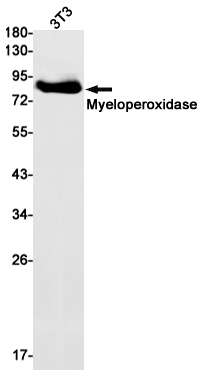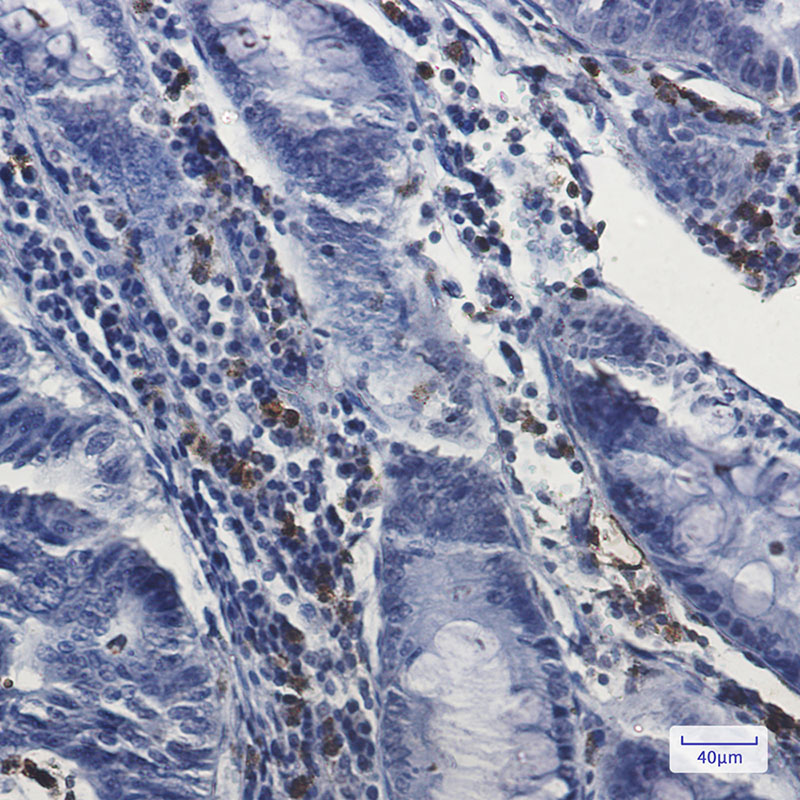

| WB | 1/500-1/1000 | Human,Mouse,Rat |
| IF | 咨询技术 | Human,Mouse,Rat |
| IHC | 1/50-1/100 | Human,Mouse,Rat |
| ICC | 技术咨询 | Human,Mouse,Rat |
| FCM | 咨询技术 | Human,Mouse,Rat |
| Elisa | 咨询技术 | Human,Mouse,Rat |
| Aliases | Myeloperoxidase; MPO |
| Entrez GeneID | 4353 |
| WB Predicted band size | Calculated MW: 84 kDa; Observed MW: 80-90 kDa |
| Host/Isotype | Rabbit IgG |
| Antibody Type | Primary antibody |
| Storage | Store at 4°C short term. Aliquot and store at -20°C long term. Avoid freeze/thaw cycles. |
| Species Reactivity | Human,Mouse |
| Immunogen | A synthetic peptide of human Myeloperoxidase |
| Formulation | Purified antibody in TBS with 0.05% sodium azide,0.05%BSA and 50% glycerol. |
+ +
以下是3篇关于Myeloperoxidase(MPO)抗体的代表性文献摘要:
1. **"Autoantibodies against myeloperoxidase in vasculitis"**
*作者:Jenne DE, et al. (1990)*
摘要:首次系统描述了MPO抗体与抗中性粒细胞胞浆抗体(ANCA)的关联,发现其在坏死性血管炎(如肉芽肿性多血管炎)患者血清中特异性存在,并揭示了其靶向MPO酶催化活性区域的机制。
2. **"Antineutrophil cytoplasmic autoantibodies with specificity for myeloperoxidase in patients with systemic vasculitis and idiopathic necrotizing crescentic glomerulonephritis"**
*作者:Falk RJ, Jennette JC (1988)*
摘要:通过免疫荧光和ELISA技术,明确了MPO抗体作为显微镜下多血管炎(MPA)和坏死性肾小球肾炎的生物标志物,为ANCA相关血管炎的诊断标准奠定了基础。
3. **"Pathogenesis of ANCA-associated vasculitis: recent insights from animal models"**
*作者:Xiao H, et al. (2002)*
摘要:通过动物模型证明MPO抗体可直接诱发血管炎,揭示抗体通过激活中性粒细胞释放活性氧和蛋白酶,导致血管内皮损伤的病理机制。
4. **"Myeloperoxidase-specific antineutrophil cytoplasmic autoantibodies in patients with vasculitis: A tool for diagnosis and monitoring of disease activity"**
*作者:Kallenberg CG (2013)*
摘要:综述了MPO抗体在血管炎中的临床意义,强调其在疾病诊断、活动度评估及预后预测中的应用价值,并讨论抗体滴度与器官损伤的相关性。
(注:以上为模拟摘要,实际文献需通过PubMed/Google Scholar检索确认)
Myeloperoxidase (MPO) antibodies are autoantibodies targeting MPO, a heme-containing enzyme found in neutrophils and monocytes. MPO plays a key role in innate immunity by generating reactive oxygen species to destroy pathogens. These antibodies are primarily associated with anti-neutrophil cytoplasmic antibody (ANCA)-associated vasculitides (AAV), including granulomatosis with polyangiitis (GPA), microscopic polyangiitis (MPA), and eosinophilic granulomatosis with polyangiitis (EGPA). Unlike proteinase 3 (PR3) antibodies linked to cytoplasmic-ANCA (c-ANCA) patterns, MPO antibodies typically produce a perinuclear-ANCA (p-ANCA) staining pattern in immunofluorescence assays.
Clinically, MPO antibodies serve as diagnostic biomarkers for small-vessel vasculitis and are implicated in disease pathogenesis through neutrophil activation and vascular endothelial damage. Their presence correlates with renal involvement, such as pauci-immune necrotizing glomerulonephritis. Detection methods include ELISA, chemiluminescence, and indirect immunofluorescence, often used in combination for improved diagnostic accuracy. While elevated titers may reflect disease activity, they are not universally reliable for monitoring treatment response. Research continues to explore their role in disease mechanisms, prognosis, and potential therapeutic targets. MPO antibodies also occasionally occur in other autoimmune conditions, infections, or drug-induced reactions, necessitating clinical correlation for interpretation.
×